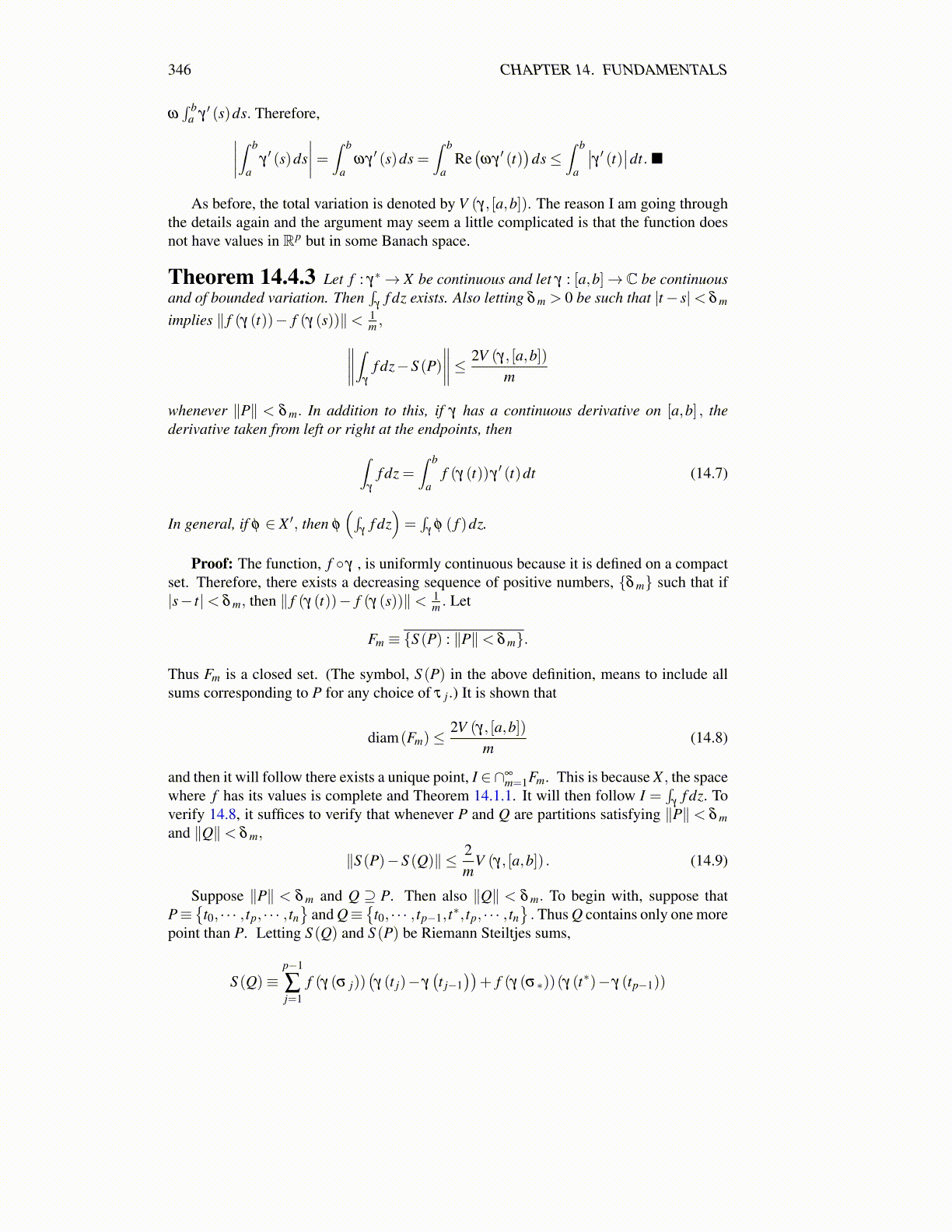
346 CHAPTER 14. FUNDAMENTALS
ω∫ b
a γ ′ (s)ds. Therefore,∣∣∣∣∫ b
aγ′ (s)ds
∣∣∣∣= ∫ b
aωγ′ (s)ds =
∫ b
aRe(ωγ′ (t))
ds≤∫ b
a
∣∣γ ′ (t)∣∣dt.■
As before, the total variation is denoted by V (γ, [a,b]). The reason I am going throughthe details again and the argument may seem a little complicated is that the function doesnot have values in Rp but in some Banach space.
Theorem 14.4.3 Let f : γ∗→ X be continuous and let γ : [a,b]→ C be continuousand of bounded variation. Then
∫γ
f dz exists. Also letting δ m > 0 be such that |t− s|< δ m
implies ∥ f (γ (t))− f (γ (s))∥< 1m ,∥∥∥∥∫
γ
f dz−S (P)∥∥∥∥≤ 2V (γ, [a,b])
m
whenever ∥P∥ < δ m. In addition to this, if γ has a continuous derivative on [a,b] , thederivative taken from left or right at the endpoints, then∫
γ
f dz =∫ b
af (γ (t))γ
′ (t)dt (14.7)
In general, if φ ∈ X ′, then φ
(∫γ
f dz)=∫
γφ ( f )dz.
Proof: The function, f ◦ γ , is uniformly continuous because it is defined on a compactset. Therefore, there exists a decreasing sequence of positive numbers, {δ m} such that if|s− t|< δ m, then ∥ f (γ (t))− f (γ (s))∥< 1
m . Let
Fm ≡ {S (P) : ∥P∥< δ m}.
Thus Fm is a closed set. (The symbol, S (P) in the above definition, means to include allsums corresponding to P for any choice of τ j.) It is shown that
diam(Fm)≤2V (γ, [a,b])
m(14.8)
and then it will follow there exists a unique point, I ∈ ∩∞m=1Fm. This is because X , the space
where f has its values is complete and Theorem 14.1.1. It will then follow I =∫
γf dz. To
verify 14.8, it suffices to verify that whenever P and Q are partitions satisfying ∥P∥ < δ mand ∥Q∥< δ m,
∥S (P)−S (Q)∥ ≤ 2m
V (γ, [a,b]) . (14.9)
Suppose ∥P∥ < δ m and Q ⊇ P. Then also ∥Q∥ < δ m. To begin with, suppose thatP≡
{t0, · · · , tp, · · · , tn
}and Q≡
{t0, · · · , tp−1, t∗, tp, · · · , tn
}. Thus Q contains only one more
point than P. Letting S (Q) and S (P) be Riemann Steiltjes sums,
S (Q)≡p−1
∑j=1
f (γ (σ j))(γ (t j)− γ
(t j−1
))+ f (γ (σ∗))(γ (t∗)− γ (tp−1))